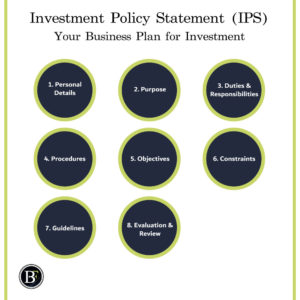Just like having a business plan before starting one. The investment policy statement (IPS) is an ideal place to start planning an investment portfolio.
IPS is a document used by portfolio manager with his client to establish an understanding of the client investments requirements in details. It works as a manual to know what the purpose, objectives, responsibilities and limitations of the investment portfolio.
Why is it Important?
If you ever experienced investing am sure you will know what I mean. Investing in general feels like going through an emotional rollercoaster. It is influenced by market fluctuations and changes in the investment’s value.
When an investor has money in liquid securities like stocks they are more likely influenced to buy or sell frequently specially nowadays when the investment in stocks decisions can be taken with a smartphone.
Holding a fixed asset like a real estate investment for example, can make the investor worried specially when anything wrong happens to the market.
Without direction investment can influence investors to take emotional decisions.
The Investment Policy Statement sets the expectation to the investor and work as a reminder for him to stay rational. It also work as a checklist and a protection for the portfolio manager to keep as a reference for the decisions made.
Enough talking about the manager and client as two different parties. Let us say you want to develop your own investment policy statement for your investments decisions.
Just note that there is no standardised format for the investment policy statement. My goal in this post is to cover most of its relevant components to help you make your own detailed or on a napkin version.

Point of Discussion(1): Do you believe investing is influenced more by emotions or logic?
The Investment Policy Statement Components
1. Personal Details
The first section is about identifying yourself, here you write down what is your age to remind yourself of your investment time horizon, whether you have a family to take care of, and your financial situation.
Just be honest with yourself and answer the question “what is my current life/financial situation?”
2. Your Purpose
After knowing your situation, now it is time to think about your purpose. How would you want to see your investment portfolio in the future?
In this section you will know whether you want your portfolio to be your passive income/retirement account, or a comprised of investments in small companies, or something in-between. This is unique for everyone, it is just the vision you want your portfolio to be and the way it generates income to you.
3. Duties and Responsibilities
Whether you are planning to invest in stock markets or buying real estate property you have to figure out the parties related to assist you. Who will execute the transactions? Who will monitor the portfolio?
Doing this section before starting will help you know exactly how much effort you will be doing. It also lets you know whether you need to look for a particular service provider(s) who will execute it for you.
4. Procedures
In this part, you want to write down the steps you will take to maintain your document to be up to date. How many times there will be reviewing your performance? Who can take the final decision in unique circumstances?
Planning this section ahead will enable you to monitor your performance and respond fast for any unexpected situation.
5. Objectives
Now my favourite part :). in the objectives section you want to get specific. You will decide on your targeted returns and risk appetite which they can either be relative or absolute.
The return objective includes your targeted return in terms percentage. For example If you say you want to make 8% return every year then your target return is absolute. But if you think about it, having an absolute fixed return target may not be achieved specially if there was a market slowdown for example. it may not be achieved without taking extra risk.
That is why you can use the relative target return as an alternative performance indicator from the beginning to be more realistic. You can say you want your investment to outperform the top 500 US companies index (S&P500) performance by 1% which is considered a relative target return.
The risk objectives is the opposite of the return objective. It will answer how much are you willing to lose whether it is an absolute or a relative? Note that there are other measurements also for identifying risk like the standard deviation and beta for example which are basically also related to fluctuations.
Having risk objectives will help you identify your risk tolerance whether against the market fluctuations or possible permanent losses. Just make sure to keep in mind your investment time horizon because the less time you have the less worth it to take risk.
6. Constraints
Ok so now you know your purpose, objectives and responsibilities they are all positive and encouraging. This section is where you remind yourself of all the investment limitations that you need to address.
First of all it is your liquidity, which is your ability to turn your investment into cash. How quick do you want to convert your investment to cash? This would influence your investing direction from whether it is buying stocks or real estate for example.
Your tax and legal requirements, are there any legal restrictions? How will you pay your taxes? Is the broker you are using safe?
Last but not least are your values. Would you mind investing in tobacco stocks? After all I am sure most of us would not want to be part of an investment that we do not believe in.
7. Guidelines
Your guidelines is a checklist of what is allowed and what is not allowed to do. It would include for example how much debt you are willing to have, and what are the specific type of investments that you do not want to include.
8. Evaluation and Review
After you clearly know your purpose, objectives, and how often you will review your goals. This section is the place where you will write down how will you evaluate and review your investment decisions.
Let us say you have invested in real estate, you would write down how will you value its price and who will be providing you feedback on the current situation.
9. Appendices
Finally, the appendices include two items. Asset allocation and rebalancing policy.
The asset allocation of your portfolio is basically an illustration of the percentage of your investments based on a certain category. It could pie charts based on asset class, companies, or geographies for example.
The rebalancing policy answers the question; do you want to sell your winning shares or buy more of your decreasing share percentage? Or will you have a different strategy balancing your portfolio?
Final Thoughts
If you notice the Investment Policy Statement components were very detailed and interrelated. I believe preparing such document can serve as a checklist where you can revisit. It can reduce the influence of emotions in your investment decisions and allow you to focus staying rational.
As Charlie Munger says, “The idea of being objective and dispassionate will never he obsolete.”
I hope you benefited from reading this post, please let me if you are enjoying investments posts and if you want us to further discuss how to start investing in stocks, fundamental and technical analysis and other topics.

Point of Discussion(2): Would you sell your winning investments to balance your portfolio?
Disclaimer: Above links below are affiliate links and at no additional cost to you, I may earn a commission. Know that I only recommend products, tools, services and learning resources I’ve personally used and believe are genuinely helpful, not because of the small commissions I make if you decide to purchase them. Most of all, I would never advocate for buying something that you can’t afford or that you’re not yet ready to implement.
Related Posts:
